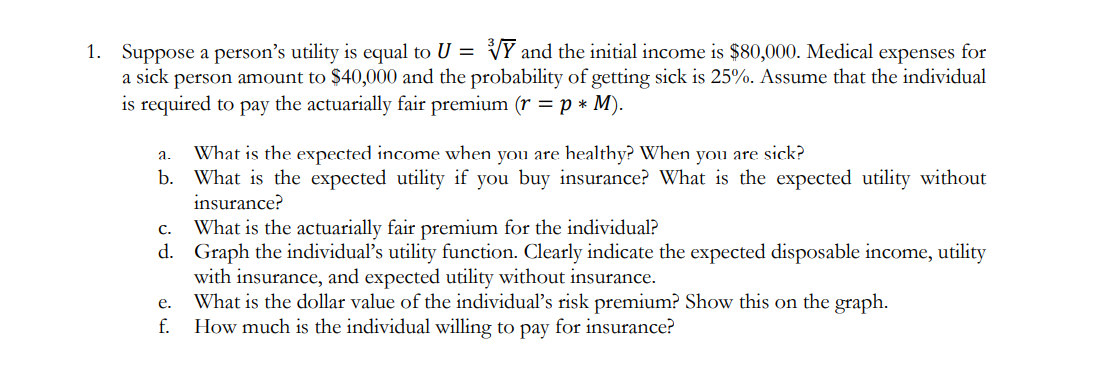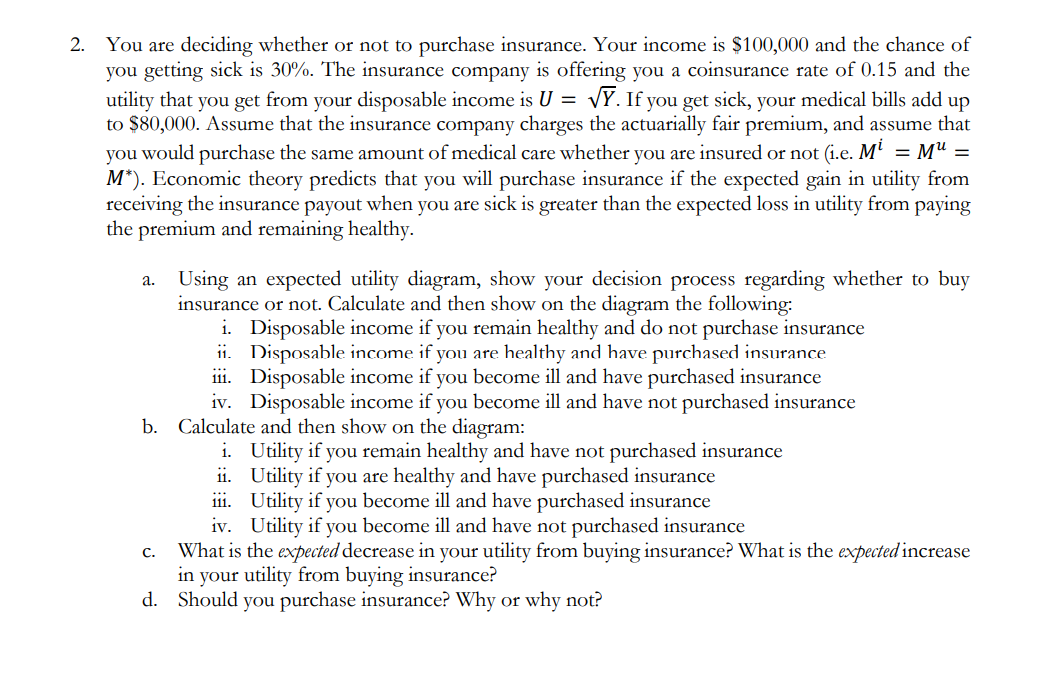You are deciding whether or not to purchase insurance. Your income is $100,000 and the chance of you getting sick is 30%. The insurance company is offering you a coinsurance rate of 0.15 and the utility that you get from your disposable income is U = √Y. If you get sick, your medical bills add up to $80,000. Assume that the insurance company charges the actuarially fair premium, and assume that you would purchase the same amount of medical care whether you are insured or not (i.e. Mi M*). Economic theory predicts that you will purchase insurance if the expected gain in utility from receiving the insurance payout when you are sick is greater than the expected loss in utility from paying the premium and remaining healthy. Using an expected utility diagram, show your decision process regarding whether to buy insurance or not. Calculate and then show on the diagram the following: i. Disposable income if you remain healthy and do not purchase insurance ii. Disposable income if you are healthy and have purchased insurance iii. Disposable income if you become ill and have purchased insurance iv. Disposable income if you become ill and have not purchased insurance b. Calculate and then show on the diagram: i. ii. iii. iv. Utility if you remain healthy and have not purchased insurance Utility if you are healthy and have purchased insurance Utility if you become ill and have purchased insurance Utility if you become ill and have not purchased insurance What is the expected decrease in your utility from buying insurance? What is the expected increase in your utility from buying insurance? d. Should you purchase insurance? Why or why not?
You are deciding whether or not to purchase insurance. Your income is $100,000 and the chance of you getting sick is 30%. The insurance company is offering you a coinsurance rate of 0.15 and the utility that you get from your disposable income is U = √Y. If you get sick, your medical bills add up to $80,000. Assume that the insurance company charges the actuarially fair premium, and assume that you would purchase the same amount of medical care whether you are insured or not (i.e. Mi M*). Economic theory predicts that you will purchase insurance if the expected gain in utility from receiving the insurance payout when you are sick is greater than the expected loss in utility from paying the premium and remaining healthy. Using an expected utility diagram, show your decision process regarding whether to buy insurance or not. Calculate and then show on the diagram the following: i. Disposable income if you remain healthy and do not purchase insurance ii. Disposable income if you are healthy and have purchased insurance iii. Disposable income if you become ill and have purchased insurance iv. Disposable income if you become ill and have not purchased insurance b. Calculate and then show on the diagram: i. ii. iii. iv. Utility if you remain healthy and have not purchased insurance Utility if you are healthy and have purchased insurance Utility if you become ill and have purchased insurance Utility if you become ill and have not purchased insurance What is the expected decrease in your utility from buying insurance? What is the expected increase in your utility from buying insurance? d. Should you purchase insurance? Why or why not?
Chapter7: Uncertainty
Section: Chapter Questions
Problem 7.5P
Related questions
Question
Please do a iv, and b i and ii

Transcribed Image Text:1. Suppose a person's utility is equal to U =
Y and the initial income is $80,000. Medical expenses for
a sick person amount to $40,000 and the probability of getting sick is 25%. Assume that the individual
is required to pay the actuarially fair premium (r = p * M).
a.
b.
What is the expected income when you are healthy? When you are sick?
What is the expected utility if you buy insurance? What is the expected utility without
insurance?
C.
What is the actuarially fair premium for the individual?
d. Graph the individual's utility function. Clearly indicate the expected disposable income, utility
with insurance, and expected utility without insurance.
What is the dollar value of the individual's risk premium? Show this on the graph.
How much is the individual willing to pay for insurance?
e.
f.

Transcribed Image Text:2. You are deciding whether or not to purchase insurance. Your income is $100,000 and the chance of
you getting sick is 30%. The insurance company is offering you a coinsurance rate of 0.15 and the
utility that you get from your disposable income is U = VY. If you get sick, your medical bills add up
to $80,000. Assume that the insurance company charges the actuarially fair premium, and assume that
you would purchase the same amount of medical care whether you are insured or not (i.e. Mi = M¹ =
M*). Economic theory predicts that you will purchase insurance if the expected gain in utility from
receiving the insurance payout when you are sick is greater than the expected loss in utility from paying
the premium and remaining healthy.
a.
Using an expected utility diagram, show your decision process regarding whether to buy
insurance or not. Calculate and then show on the diagram the following:
i. Disposable income if you remain healthy and do not purchase insurance
ii.
Disposable income if you are healthy and have purchased insurance
iii. Disposable income if you become ill and have purchased insurance
iv. Disposable income if you become ill and have not purchased insurance
b. Calculate and then show on the diagram:
i. Utility if you remain healthy and have not purchased insurance
ii.
Utility if you are healthy and have purchased insurance
iii.
Utility if you become ill and have purchased insurance
iv. Utility if you become ill and have not purchased insurance
What is the expected decrease in your utility from buying insurance? What is the expected increase
in your utility from buying insurance?
d. Should you purchase insurance? Why or why not?
C.
Expert Solution
This question has been solved!
Explore an expertly crafted, step-by-step solution for a thorough understanding of key concepts.
Step by step
Solved in 3 steps

Knowledge Booster
Learn more about
Need a deep-dive on the concept behind this application? Look no further. Learn more about this topic, economics and related others by exploring similar questions and additional content below.Recommended textbooks for you


Essentials of Economics (MindTap Course List)
Economics
ISBN:
9781337091992
Author:
N. Gregory Mankiw
Publisher:
Cengage Learning

Brief Principles of Macroeconomics (MindTap Cours…
Economics
ISBN:
9781337091985
Author:
N. Gregory Mankiw
Publisher:
Cengage Learning


Essentials of Economics (MindTap Course List)
Economics
ISBN:
9781337091992
Author:
N. Gregory Mankiw
Publisher:
Cengage Learning

Brief Principles of Macroeconomics (MindTap Cours…
Economics
ISBN:
9781337091985
Author:
N. Gregory Mankiw
Publisher:
Cengage Learning